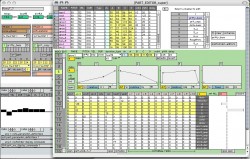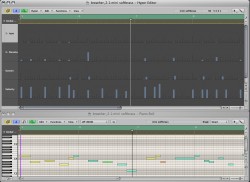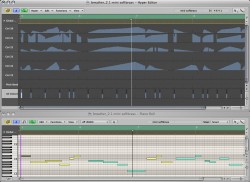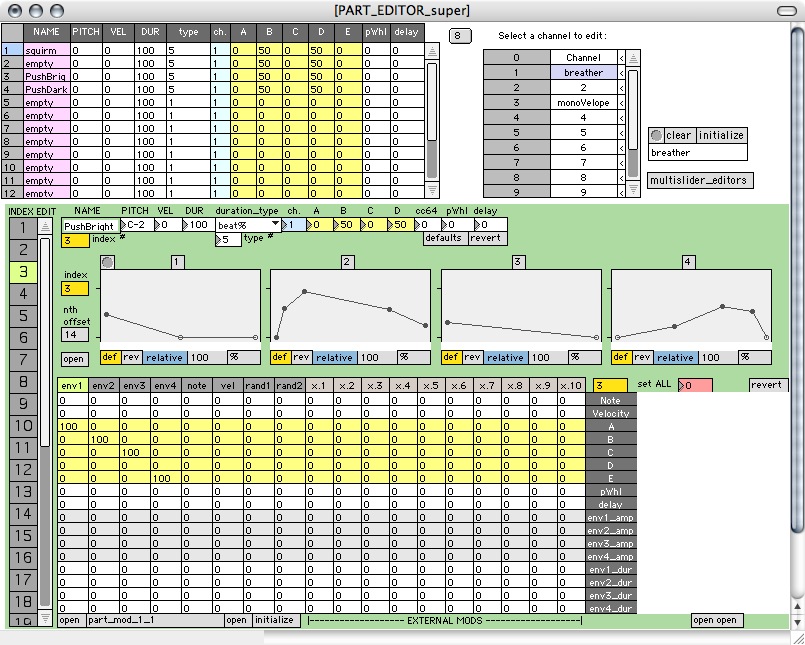Ronny Turiaf – Basics

Disclaimer: Ronny Turiaf, the former Laker who now plays for the Golden State Warriors has nothing to do with this program! I just borrowed his name because the first sounds I made with the patch reminded me of the sound of his name…
Purpose
Ronny Turiaf was built to enable dynamic, animated performances out of written MIDI sequences. It can best be thought of as storing a bank of customizable articulations which create complex transformations over a variable length of time.
How it works
Ronny Turiaf takes an input MIDI sequence of pitch/note values with two additional values (for Articulation and Duration) to tell Ronny Turiaf how to calculate its modulation envelopes. It will take these values and turn them into a note/velocity pair plus a stream of MIDI CC messages for up to 6 parameters to add dynamism to the performance. You can route this information to any software or hardware which responds to MIDI information.
Input MIDI
Using Ronny Turiaf requires just a few additional bits of information on top of the most basic MIDI sequence (i.e., notes represented as Pitch and Velocity combinations). These are:
- Articulation/Type: Specifies the articulation index to be used for this note or note group.
- Duration: Specifies the length of the note.
- Sustain Pedal: (Optional) This can be used to include multiple notes under the arc of a single articulation.


Articulation Parameters
Articulations create new/additional performance information for the following parameters:
- (A,B…E) = MIDI CC x 5: Any 5 MIDI Control Change numbers may be used. Within the articulation bank these are represented by A-E. The CC number for a specific output is the assign at the point of output.
- pWhl: This represents the MIDI Pitch Bend controller.
- Ch (Channel: You can assign the output elements to a different MIDI Channel than the input information if desired. This is useful because you may send different articulations to different targets entirely.
- Pitch: You can override any input pitch by specifying a specific pitch for an articulation. This is most useful for creating percussive sounds with a consistent pitch base.
- Vel: You can override any input velocity by specifying a fixed velocity base for the articulation.
- Dur: Duration of the articulation affects how long a note is sustained and how long the modulation envelopes take to run their course.
The basic premise for using any of the above parameters is the same: specify a base value for the value and then modulate using the modulation envelopes and/or input parameters like pitch, velocity or either of two randomizers. Their effects will appear idiomatic to anyone familiar with synthesizer modulation settings.
The Modulation Envelopes

The primary difference between the performances achievable using Ronny Turiaf and using a synthesizer’s built-in modulation capabilities lies in the envelopes. Ronny Turiaf can calculate the run of its envelopes based on the duration of the note. By linking the envelope directly to the length of the note the amount of change over time can be scaled in a more musical fasion.
For instance, if a particular articulation swells from a quiet dark sound to a bright loud one, the effect can be stretched over a fraction of a beat or several bars depending on the length of the note. The closest most synths can come is by using a MIDI control to modulate all parts of the AHDSR envelope equally but this requires knowing the exact curve of the modulation range for both the absolute and beat-sync timing options for the envelope (assuming you are allowed to set these).
One other major advantage of using an external system to do this is that you can modulate elements outside of synthesizers with these envelopes such as external effects devices or plug-ins.